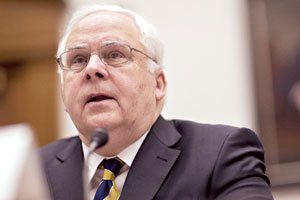Senior Reporter
Industry Slams P3s Proposal

This story appears in the Feb. 6 print edition of Transport Topics.
Transportation policymakers and industry stakeholders rejected the Trump administration’s proposal that private sector investments would significantly upgrade the country’s infrastructure over the next few years.
The lawmakers and executives representing labor groups, manufacturers, automakers and freight shippers agreed that a variety of funding proposals, such as increasing taxes on fuel and charging drivers for the miles they travel, would do more than public-private partnerships, or P3s, to modernize roads, bridges and pipelines. They expressed their views at a House Transportation and Infrastructure Committee hearing Feb. 1.
The committee’s leaders, Chairman Bill Shuster (R-Pa.) and ranking Democrat Peter DeFazio of Oregon, sounded the alarm on the need for a long-term funding plan and on the growing cost to industries and commuters resulting from congestion. Rep. Mike Capuano (D-Mass.), a transportation authorizer who co-led a task force on P3s during the 113th Congress, reminded colleagues P3s are ideal for about 10% of big-ticket maintenance and construction projects.
“We need more money,” Capuano said. “Thus far, the smoke signals coming out of the new administration is that somehow we’re going to do this with just public-private partnerships, no new money.”
FedEx Corp. Chairman and CEO Fred Smith emphasized Capuano’s point.
“I think [P3s] is something that could do some things, but what needs to happen is to increase the gasoline and diesel taxes. I told it to the administration as late as yesterday,” Smith said, noting that trucks stuck in traffic waste fuel and cut into productivity. In his testimony, Smith cited the American Society of Civil Engineers, which found the country’s substandard roads cost each car driver $324 annually in repairs.
Rep. Frederica Wilson (D-Fla.) urged Smith to elaborate on the effects poor infrastructure has on his company.
Smith brought up truck tires.
“Over the past 20 years, our over-the-road vehicle tire utilization has been cut in half. So we’re using almost 100% more tires to produce the same mileage of transportation. Why is that? Because the road infrastructure has so many potholes in it, it’s tearing up tires faster than was the case,” Smith said.
AFL-CIO President Richard Trumka added that P3s have limited applicability because they often rely on high-volume traffic for revenue.
“Most of our nation’s traditionally public infrastructure is public because whatever user fees it generates, if any, cannot fund it on a stand-alone basis when risk and return on private capital is taken into account,” Trumka said in prepared remarks. “We need to understand creative infrastructure financing as fundamentally supplemental to basic public financing.”
Dozens of transportation groups expressed concern about conditions with structurally deficient infrastructure in a letter to Trump on Feb. 1.
“Private financing, while important and needed, cannot replace the role of public funding and federal leadership,” wrote groups ranging from American Trucking Associations to the International Bridge, Tunnel and Turnpike Association.
The bipartisan consensus critical of P3s was a blow to an administration that has argued private sector contributions would help remedy the conditions of waterways, freight corridors, tunnels and runways. Last week, the Senate confirmed Elaine Chao to lead the U.S. Department of Transportation. Prior to her confirmation, Chao had told senators that the administration would look to expand the role P3s play. During the campaign, Trump’s advisers proposed investing $1 trillion in infrastructure over 10 years by providing tax credits for private investors.
Republicans in control of Congress have yet to indicate when they would look to advance a long-term funding plan that would address big-ticket maintenance and construction projects.
At the three-hour House hearing, lawmakers and witnesses also touched on trade, autonomous vehicles and longer combination trailers for trucks.
Smith pressed the committee to acknowledge there are benefits in allowing the freight industry to rely on twin 33-foot trailers. Doing so, he said, would enhance productivity, safety and environmental efficiency nationwide.
“In several years of operations in Florida and elsewhere, FedEx drivers have told us repeatedly that they find them to be more stable,” Smith said in prepared remarks. “Safety will be enhanced simply by reducing the trips and mileage driven, with industry estimates of 1.3 billion fewer miles driven.”
A nationwide adoption of the longer combination trailers — 28 feet is the allowable length for twin trailers nationwide absent special permits — would not represent an increase in gross vehicle weight, and it would allow carriers to increase the volume of shipments carried up to 18%, before tacking on incremental trips, Smith said. He also noted longer trailers would reduce CO2 emissions by 4.4 billion pounds of carbon, resulting in savings of more than 200 million gallons of fuel annually.
Shuster, while receptive to Smith’s proposal, would not say if he intends to propose authorizing the trailers in a highway policy bill.
“I think it’s something that is safe. They utilize it today, and it increases the capacity without adding a single lane to the highways,” Shuster told reporters after the hearing.
Last month, FedEx announced it had joined Americans for Modern Transportation, a coalition of shippers and retailers planning to urge Congress to support nationwide approval of the longer trailers. The coalition includes UPS Inc. and Amazon.com. “We need to lay the groundwork for a modern transportation system,” the coalition wrote. “Central to this goal is combining infrastructure enhancements with efficient trucking and policies as well as incentives for better safety and fuel technology.”
FedEx ranks No. 2 on the Transport Topics Top 100 list of the largest U.S. and Canadian for-hire carriers. UPS is No. 1.
Opponents suggest motorists unfamiliar with the longer trailers on roadways would find them problematic on their commutes.

